Pontiac Trans Sport
The Pontiac Trans Sport is a series of minivans that was marketed by the Pontiac division of General Motors. The first light truck ever sold by Pontiac, the Trans Sport (a pun on transport) was sold across two generations from the 1990 to 1999 model years. The Trans Sport was slotted between the Chevrolet Lumina APV (replaced by the Chevrolet Venture) and the Oldsmobile Silhouette. The first Pontiac since the T1000 to have no direct predecessor, the Trans Sport took on the role of the 6000 Safari station wagon (in line with the Lumina APV replacing the Celebrity wagon).
| Pontiac Trans Sport | |
|---|---|
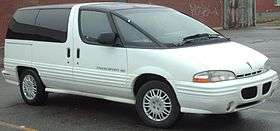 First-generation Pontiac Trans Sport SE (post-facelift) | |
| Overview | |
| Manufacturer | General Motors |
| Production | 1989–1998 |
| Model years | 1990–1999 |
| Body and chassis | |
| Class | Minivan |
| Layout | Transverse front-engine, front-wheel drive |
| Platform | U-body |
| Chronology | |
| Predecessor | Pontiac 6000 Safari (indirect) |
| Successor | Pontiac Montana |
Introduced a year before the second-generation Chrysler minivans, the Pontiac Trans Sport and its counterparts marked an industry shift in the minivan segment towards adopting the form factor used by Chrysler. Though the APV minivans used a model-specific chassis, the vehicles used a front-wheel drive, transverse-engine configuration, sharing mechanical commonality with sedans.
During its production, the Trans Sport was assembled by GM at North Tarrytown Assembly (Tarrytown/Sleepy Hollow, New York), shifting production to Doraville Assembly (Doraville, Georgia) for its second generation. For the 1998 model year, Pontiac renamed the Trans Sport the Pontiac Montana, deriving the name from an exterior trim package introduced for 1997; the Montana was sold in two generations through 2009 (2006 in the United States).
Background
The Trans Sport and its siblings were created by General Motors in order to compete with the then-dominant Chrysler minivans. The larger Chevrolet Astro and corporate cousin GMC Safari were based on a body-on-frame, rear wheel drive truck platform, and thus did not appeal to the same market segment as Chrysler's vans.
Concept
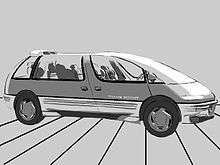
A Trans Sport concept was first presented in 1986, and included futuristic styling and features such as gullwing doors, a built-in Nintendo Entertainment System, and a glass roof. This concept was well-received, and a production Trans Sport was greenlit in 1987. Most of the concept's standout features were not translated to the production Trans Sport, with the gullwing doors being deemed too expensive to produce, and the glass roof being traded for gloss black paneling due to weight and cost issues.
Two other GM marques, Chevrolet and Oldsmobile, were also given vehicles based on the same platform as the Trans Sport, the Lumina APV and Silhouette respectively. In accordance with those brands' images, the Trans Sport was targeted at sport- and style-oriented buyers, while the Lumina and Silhouette targeted the value and premium markets respectively.
Technology
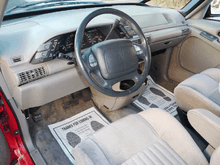
The Trans Sport, along with the Lumina APV and Silhouette, rode on the U-body platform and was constructed from a galvanized steel space frame, featuring dent and rust resistant polymer plastic body panels on the side and a galvanized steel roof. Similar construction was employed on the Pontiac Fiero, as well as some GM Saturn vehicles.
The Trans Sport had three seating options. The base trim featured a five-seat configuration, with three removable bucket seats in the second row (in contrast to the bench seats more commonly found in five-passenger vehicles). A seven-seat configuration, adding two removable bucket seats in a third row, was also offered. The Trans Sport in SE and GT trims offered a six-seat configuration, with two buckets per row.
Air suspension was offered as an option.
The 1994 Trans Sport featured the first powered sliding side door in a production vehicle; this was initially intended to debut in 1993, but was pushed back due to technological difficulties. The Trans Sport also added a driver's-side airbag in 1994.
For model years 1994 and 1995, traction control was optional with the 3800 engine, and became standard in 1996 with the 3.4-liter V6.
Reception

A focal point of the U-body minivans at the time of their release was their styling. The Chrysler minivans with which they competed had more traditional, conservative styling cues, and GM felt that there existed an untapped market for a sport-styled van. This styling was received negatively by automotive critics, and the vans came to be called "dustbusters" colloquially, after the handheld vacuum cleaner of the same name. Moreover, the unusually long and harshly sloped windshield, and resultant long distance to the windshield's base from the driver's position, made the vehicles disconcerting to drive for someone without prior experience. Thanks to these criticisms, as well as mediocre sales and mockery in Chrysler advertisements, the Trans Sport and Lumina APV were facelifted in 1994. The nose was shortened by 3 inches, some cladding was removed, and the interior dashboard received a ridge to lessen the perceived distance to the windshield's base. The European market did not receive this facelift, as the vans' initial styling had not been negatively received there. For model years 1994 and after, the European Trans Sport became an Oldsmobile Silhouette (which had not been facelifted in the U.S. market) with Pontiac badging.
At launch, the Trans Sport's 3.1-liter V6 was received as underpowered for the relatively large vehicle. This was rectified in the 1992 model year, with a 3.8-litre V6 offering improved torque and acceleration becoming optional. In 1995, a 1.9-liter turbodiesel by PSA became an option in the European market.
First generation (1990-1996)
| First generation (GMT199) | |
|---|---|
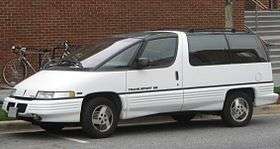 | |
| Overview | |
| Production | 1990–1996 |
| Assembly | Tarrytown, New York, U.S. |
| Body and chassis | |
| Body style | 3-door van |
| Layout | Transverse front-engine, front-wheel drive |
| Platform | U-body/GMT199 |
| Related | Chevrolet Lumina APV Oldsmobile Silhouette |
| Powertrain | |
| Engine | |
| Transmission | |
| Dimensions | |
| Wheelbase | 109.8 in (2,789 mm) |
| Length | 1993–96: 194.5 in (4,940 mm) 1990–92: 194.7 in (4,945 mm) |
| Width | 74.6 in (1,895 mm) |
| Height | 1993–96: 65.7 in (1,669 mm) 1990–92: 65.2 in (1,650 mm) |
| Curb weight | 3,600–3,900 lb (1,630–1,770 kg) |
1990
- All new model.
- Available as Trans Sport (with silver cladding) and Trans Sport SE (monochromatic), both offered the 120-hp 3.1L V6 and three-speed automatic.
- Launched in Europe with minor differences in exterior trim required for regulatory concerns as well as engine and transmissions appropriate for Europe's differing fuel cost and vehicle taxation structure. In some European countries sold through Opel dealers.
1991
- Customer complaints regarding glare reflected on the interior of the windshield from the massive expanse of the dashboard led to the addition of black carpeting in lieu of the more reflective plastic used in the previous year.
- Power windows and door locks made standard on American models.
- A manual sunroof was newly available.
1992
- Base model was discontinued and a sporty GT model was added.
- Newly available for 1992 was GM's 3800 V6 engine coupled with a Hydra-Matic 4T60 4-speed electronically controlled automatic transmission. It was standard on the GT, optional for SE.
- With the departure of the base model, silver cladding was no longer available.
- Leather seating became available as an option on the GT model. Previously, leather seating was an Oldsmobile Silhouette exclusive within the U-body minivans.
- The cowl-mounted fixed radio antenna mast was eliminated, and an integrated roof antenna was installed, sandwiched between the roof and the headliner.
- Side view mirrors were changed to the folding type and were enlarged to provide better rear-ward visibility.
- Brakes were enlarged and anti-lock brakes (ABS) was added as standard equipment.
- Steering wheel-mounted controls for the stereo system were added as an option on SE and standard on GT.
1993
- Due to very slow sales in 1992, the Trans Sport GT was dropped after one year. Trans Sport SE continues; it would be the only trim level available from 1993 to 1996. The SE model could be outfitted with any of the GT's options.
- The text badges were changed from black to the van's colours.
- A remote controlled power sliding side door was announced for 1993, but failed to actually make it into production that year due to quality control problems.
- A new color scheme with gold cladding, gold wheels and a body-colored roof behind the C-pillar was available as an extra-cost option with certain exterior colors.
- A redesigned center console was added this year with revamped, larger climate controls, a large storage cubby and a large storage bin at its base.
1994
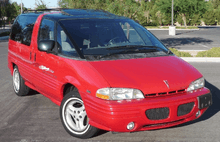
- The exterior styling was revamped, three inches (76 mm) were trimmed off the nose. Headlights taken from the Pontiac Bonneville were installed with Bumper-mounted fog lamps added as standard equipment and cladding was made less flamboyant and stylized.
- In an effort to lessen the perceived distance to the base of the windshield, a ridge was added to the interior dash finishing panel.
- The power sliding door became available as an option, after being introduced in 1993.
- Built-in child seats for the second row became available as an option.
- A traction control system became available as an option with the 3.8L V6.
- Rear deep-tinted windows now featured a darker tint than previously used.
- A driver's side airbag became standard equipment.
1995
- Automatic power door locks that engaged/disengaged with the transmission shifting into or out of "park" added as a standard feature of the power door lock option package.
- Rear portion of the roof, behind the C-pillar previously painted black as standard with body color as a no-cost option, would be only available painted body color as a further effort to "normalize" the vehicles' looks as compared to competitors.
1996
- Both 3.1 and 3.8 L V6 engines dropped, a 3.4 L V6 3400 engine became the only power plant available.
- There were few other changes, due to a completely redesigned 1997 model, to debut in summer 1996.
European Market

For the European market, the Oldsmobile Silhouette was sold as the Pontiac Trans Sport by replacing the Oldsmobile badging with Pontiac badging, along with Pontiac wheels. Sales in Europe were good for an American import, but did not represent enough volume to make a fourth, distinct model economically feasible. The Pontiac Trans Sport of Europe was discontinued in 1997. Its successors were both the Chevrolet Trans Sport (Second gen Pontiac Trans Sport rebadged as a Chevrolet) (LWB), and the Opel Sintra (SWB). In the United Kingdom, it was sold as the Vauxhall Sintra.
Second generation (1997-1999)
| Second generation (GMT200) | |
|---|---|
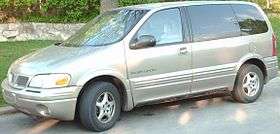 | |
| Overview | |
| Also called | Chevrolet Trans Sport (Europe, 1997-2004) Pontiac Montana (USA, 1999 - 2004; Canada, 2000-2004) |
| Production | August 6, 1996–1998 (United States and Mexico) September 1996-1999 (Canada) |
| Model years | 1997-1998 (United States and Mexico) 1997-1999 (Canada) |
| Assembly | Doraville, Georgia, United States |
| Body and chassis | |
| Body style | 3-door minivan 4-door minivan |
| Platform | U-body/GMT200 |
| Related | Chevrolet Venture Chevrolet Uplander Buick GL8 Buick GL8 First Land Buick Terraza Oldsmobile Silhouette Opel Sintra/Vauxhall Sintra Pontiac Trans Sport Montana Pontiac Montana Pontiac Montana SV6 Saturn RELAY Buick Rendezvous Pontiac Aztek |
| Powertrain | |
| Engine | 3.4 L (207 CID) LA1 3400 V6 |
| Transmission | 4-speed automatic |
| Dimensions | |
| Wheelbase | SWB: 112.0 in (2845 mm) LWB: 120.0 in (3048 mm) |
| Length | SWB: 187.3 in (4757 mm) LWB: 201.3 in (5113 mm) |
| Width | 72.7 in (1847 mm) |
| Height | SWB: 67.4 in (1712 mm) LWB: 68.1 in (1730 mm) |
1997–1999
In the 1997 model year, the Trans Sport and its siblings got their first major redesign, ditching the one-of-a-kind construction and look to create a more conservative, conventional minivan. Gone were spaceframes, plastic body panels, and sleek styling. The new minivans were of unibody steel construction and the styling was intentionally conventional to such an extent that contemporary reviewers remarked that without looking closely at the badging and grille treatments, these minivans could be mistaken for their primary competitors, the Dodge Caravan and Plymouth Voyager, which at the time commanded a 50% share of the minivan market. During the development of this generation of the U-body minivan, General Motors extensively benchmarked the then current Chrysler minivans. The resultant vehicles more closely resembled the immensely successful trio; However, Chrysler would launch a completely redesigned minivan line a year before GM. The last model year for the Trans Sport was 1998 in the U.S. and 1999 in Canada. The Doraville, Georgia assembly plant that produced the Trans Sport closed on September 26, 2008.
Safety criticism
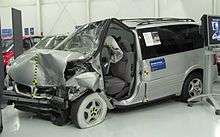
A crash test video[1] of the 1997-2004 Trans Sport/Montana resulted in criticism because of extreme damage to the vehicle in the 40 mph (64 km/h) crash test. The minivan received a "Poor" rating by the Insurance Institute for Highway Safety (IIHS), and some comments made by the IIHS were
- Major collapse of the occupant compartment left little survival space for the driver.
- Extreme steering wheel movement snapped the dummy's head backward.
- The unnatural position of the dummy's left foot indicates that an occupant's left leg would have been seriously injured in a real-world crash of this severity.
- The forces on the left lower leg were so high that the dummy's metal foot broke off at the ankle.
European market
This version of the Pontiac Trans Sport was also sold in Europe as a Chevrolet, alongside the Opel/Vauxhall Sintra; however, unlike the Sintra, which was based on the Pontiac Trans Sport, Pontiac Montana, Chevrolet Venture, Oldsmobile Silhouette and the previous generation Buick GL8, but wore the European Opel or British Vauxhall badges and trim, the Chevrolet Trans Sport (as it was known) was trimmed and badged exactly like the Pontiac Trans Sport, the only differences being where Chevrolet badges were used in place of the Pontiac badges. In all cases, the European-market vans used different front, side and rear lighting equipment, different seat belts and sundry other safety items, to comply with ECE regulations which differ from US safety standards. These models were discontinued between 2003 and 2005, depending on the market. Despite limited sales in most of Europe, the vehicle was particularly successful in Sweden - where it was the best selling minivan for a while. While production ended in 2005, European stock lasted until 2007.
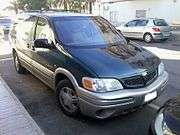 Chevrolet Trans Sport (Europe).
Chevrolet Trans Sport (Europe).
1997–2005
For the 1997 and 1998 model year (1999 in Canada), along with the roll out of this new generation of minivans, the Pontiac (Trans Sport) Montana was debuted, which had special cladding and wheels intended to give it a more rugged SUV-like appearance. In the 1999 model year (2000 in Canada), the name "Trans Sport" was dropped due to the popularity of the "Montana" appearance package. By the time the "Trans Sport" moniker was dropped, the "Montana" package accounted for over 80% of total Trans Sport sales. This also had to do with the fact that Montana become popular as an advertising name for several products in general around this time.
 Pontiac Trans Sport Montana.
Pontiac Trans Sport Montana.
Engine:
- 1997–1998 3.4 L (207 CID) LA1 3400 V6
References
- StickyCheese2000. "Why do people buy a Montana? Another video about its safety". YouTube. Retrieved 2011-11-27.